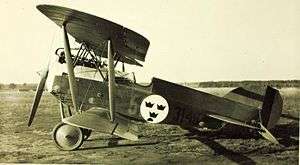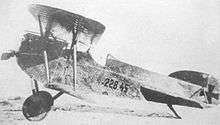Phönix D.I
| Phönix D.I, D.II, and D.III | |
|---|---|
 | |
| Phönix D.III of the Swedish Air Force | |
| Role | Biplane fighter |
| National origin | Austria-Hungary |
| Manufacturer | Phönix Flugzeug-Werke |
| First flight | 1917 |
| Primary user | KuKLFT |
| Number built | 158 |
|
| |
The Phönix D.I, with the D.II and D.III variants, was an Austro-Hungarian First World War biplane fighter built by the Phönix Flugzeug-Werke and based on the Hansa-Brandenburg D.I.[1]
Development
The Phönix D.I was the second design developed by the Phönix Flugzeug-Werke based on Hansa-Brandenburg D.I design which it has produced under licence.[2] The D.I was a single-seat biplane fighter with improvements over the original Hansa-Brandenburg design which included more efficient wings, a more powerful engine and structural improvements.[2] A prototype was first flown in 1917 and proved to be fast but difficult to handle but because of the urgent need for fighters the D.I entered production. To improve the problems a modified variant, the D.II was introduced with balanced elevators and balanced ailerons on the upper wings. A further development was the D.III which had balanced ailerons on both wings and a more powerful 230 hp (172 kW) Hiero in-line engine. The last of 158 aircraft of all three types was delivered on 4 November 1918.
Operational service
Army D.I's entered service in December 1917. It was used as an escort fighter by Fliks 4/D, 15/D, 17/D, 48/D, 54/D and 66/D. (D-Fliks were small general-purpose units, capable of short-range reconnaissance, bombing, defense and artillery-spotting duties, consisting of 4-5 aircraft, both single-seat fighters and twin-seat observation/light bomber types.) It was used as a fighter in Fliks 14/J, 30/J, 60/J, 61/J and 63/J. (J-Fliks - J for "Jagd", i.e. Hunting - were fighter units, having an official complement of 18 aircraft, something that very few had in practice.) It was favorably received by pilots, not least by those that were used to flying twin-seaters who found it stable, robust and easy to fly. (One complaint however, was that the D.I was "almost too stable for quick combat maneuvers".) Some were equipped with cameras and thus converted to dedicated reconnaissance machines.[3]

Several Austro-Hungarian aces used this aircraft, among them Kurt Gruber, Roman Schmidt, Karl Teichmann, Godwin Brumowski, Benno Fiala Ritter von Fernbrugg, Franz Gräser, Karl Nikitsch, Frank Linke-Crawford and József Kiss - who was killed while flying a D.II on May 24, 1918.[4]
Variants
- D.I
- Initial production variant with a 200hp (149kW) Hiero inline engine.[2]
- D.II
- Improved variant with balanced elevators and balanced ailerons on the upper wings.[2]
- D.III
- Improved variant with balanced ailerons on both wings and powered by a 230hp (172kW) Hiero in-line engine.[2]
Operators
- Swedish Air Force - Postwar
- Royal Yugoslav Air Force - Postwar.
Specifications (D.1)
Data from Orbis 1985, page 2700
General characteristics
- Crew: 1
- Length: 6.65 m (21 ft 9¾ in)
- Wingspan: 9.75 m (31 ft 11¾ in)
- Height: 2.80 m (9 ft 2¼ in)
- Gross weight: 805 kg (1775 lb)
- Powerplant: 1 × Hiero 6-cylinder inline piston, 149 kW (200 hp)
Performance
- Maximum speed: 180 km/h (112 mph)
- Endurance: 2 hours 0 min
- Service ceiling: 6000 m (19,685 ft)
Armament
- 2 x Synchronised fixed forward-firing 8 mm Schwarzlose machine guns
References
Bibliography
- Taylor, Michael J. H. (1989). Jane's Encyclopedia of Aviation. London: Studio Editions.
- The Illustrated Encyclopedia of Aircraft (Part Work 1982-1985). Orbis Publishing.
- Lamberton, W.M. (1960). Fighter Aircraft of the 1914-1918 War. Herts: Harleyford Publications Ltd. pp. 22–23.
- Grosz, Peter M. (1993). Austro-Hungarian Army Aircraft of World War One. Mountain View, CA: Flying Machines Press. pp. 118ff.
- Chant, Christopher (2002). Austro-Hungarian Aces of World War 1. Wellingborough, UK: Osprey Publishing. pp. 50ff.
- О. Петровић; Војни аероплани Краљевине СХС/Југославије (Део I : 1918 – 1930.), Лет 2/2000. Београд, 2000.
External links
- http://srpskaenciklopedija.org/index.php?title=%D0%A4%D0%B5%D0%BD%D0%B8%D0%BA%D1%81_D Phönix D (Феникс D)
- http://www.vazduhoplovnetradicijesrbije.rs/index.php/istorija/308-phonix-d Phоnix D